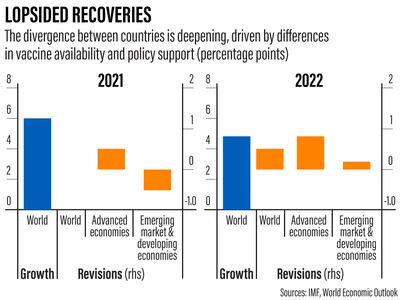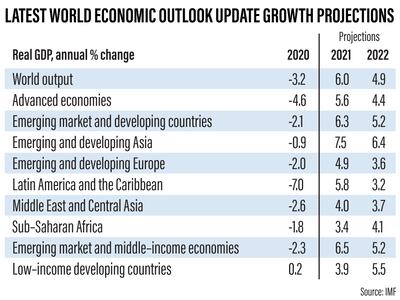The International Monetary Fund maintained its global economic forecast at 6 per cent but downgraded its growth outlook for emerging market and developing economies due to the uneven access to vaccines and the emergence of Covid-19 variants that are hindering the shape of recovery.
The fund said multilateral action has a vital role in diminishing divergence across countries and strengthening global prospects.
The pandemic reduced per capita incomes in advanced economies by 2.8 per cent, relative to pre-pandemic trends over 2020 to 2022, compared with an annual per capita loss of 6.3 per cent a year for emerging market and developing economies (excluding China), according to fund estimates.
“Vaccine access has emerged as the principal fault line along which the global recovery splits into two blocs: those that can look forward to further normalisation of activity later this year [almost all advanced economies] and those that will still face resurgent infections and rising Covid death tolls,” the Washington lender said in its latest update to its World Economic Outlook on Tuesday.
"The recovery, however, is not assured even in countries where infections are currently very low so long as the virus circulates elsewhere.”
The fund issues its growth forecasts every three months and has emphasised that the outlook depends on the success of vaccination programmes and how effectively economic policies can limit lasting damage from the world's deepest recession since the Great Depression.

The IMF upgraded its 2022 outlook for the global economy by half a percentage point to 4.9 per cent. This was largely due to it upgrading advanced economies, specifically the US, because of additional fiscal support from the Biden administration that is expected in the second half of 2021 and an improved health outlook across peer countries.
Advanced economies are now set to grow 5.6 per cent this year, with the US, the biggest of the group, forecast to expand 7 per cent after shrinking by 3.5 per cent last year.
Emerging market and developing economies are now projected to grow 6.3 per cent this year, with China and India hitting 8.1 per cent and 9.5 per cent, respectively.
The Middle East and Central Asia are forecast to grow 4 per cent after shrinking 2.6 per cent in 2020. Saudi Arabia, the Arab world’s largest economy, is forecast to grow 2.4 per cent after shrinking 4.1 per cent last year.
Low income and developing countries are projected to expand a modest 3.9 per cent this year after growing 0.2 per cent in 2020.
“These revisions reflect to an important extent differences in pandemic developments as the delta variant takes over,” said Gita Gopinath, the IMF's chief economist.
“Faster-than expected vaccination rates and [a] return to normality have led to upgrades, while lack of access to vaccines and renewed waves of Covid-19 cases in some countries, notably India, have led to downgrades.”

About 40 per cent of the population in advanced economies has been fully vaccinated, compared with 11 per cent in emerging market economies and a small fraction in low-income developing countries.
“While more widespread vaccine access could improve the outlook, risks on balance are tilted to the downside,” said Ms Gopinath.
“The emergence of highly infectious virus variants could derail the recovery and wipe out $4.5 trillion cumulatively from global GDP [gross domestic product] by 2025,” she said.
“Financial conditions could also tighten abruptly amid stretched asset valuations if there is a sudden reassessment of the monetary policy outlook, especially in the US. It is also possible that stimulus spending in the US could prove weaker than expected.”
Another factor contributing to the divide between how economies perform is the scale of policy support from central banks and governments.
While fiscal support in advanced economies is continuing with $4.6tn of pandemic-related measures available in 2021 and beyond, such actions expired last year in emerging market and developing economies and countries are looking to rebuild fiscal buffers, said Ms Gopinath.
Inflation in advanced economies has been raised to an estimated 2.4 per cent and average 5.4 per cent in emerging market and developing economies. Although rising inflation is expected to subside in advanced economies, it presents challenges for emerging market and developing countries and is expected to remain elevated in 2022, due to higher food prices.
Moving forward, it will be crucial for financially constrained economies have access to international liquidity and for major central banks to communicate their outlook for monetary policy and ensure that inflation fears do not trigger rapid tightening of financial conditions, said Ms Gopinath.
“A worsening pandemic and tightening financial conditions would inflict a double hit on emerging market and developing economies and severely set back their recoveries,” she said.
Global trade is set to improve after a rebound in the second half of last year due to pent-up demand for consumer durables from advanced economies, such as cars, and the resumption of supply chains in emerging markets.
The fund raised its estimate on growth of trade to 9.7 per cent this year and 7 per cent next year after it shrunk by 8.3 per cent in 2020.
Oil prices are expected to rise close to 60 per cent this year above their low base of $41.29 a barrel in 2020, with the fund forecasting an average based on futures markets (as of June 2, 2021) of $64.68 in 2021 and $63.02 in 2022.
Non-oil commodity prices are expected to rise close to 30 per cent above 2020 levels, reflecting particularly strong increases in the price of metals and food.
Total government debt reached an unprecedented level of close to 100 per cent of global GDP in 2020 and is projected to remain around that level in 2021 and 2022.
Globally, governments provided $16.5tn in fiscal support last year, backed by $9tn in monetary accommodation from central banks.
Last year’s downturn saddled emerging market and developing countries with more debt and limited their capacity to address rising poverty and inequality levels.
The uneven distribution of vaccines has produced diverging recovery paths, with some countries barely inoculating their population. Multilateral co-operation is imperative to ensure access to vaccines and therapeutics globally in order combat the pandemic and help ensure the economic recovery of vulnerable countries, the IMF said.
“This would save countless lives, prevent new variants from emerging and add trillions of dollars to global economic growth,” said Ms Gopinath.
“It is important to remove trade restrictions on vaccine inputs and finished vaccines and make additional investment in regional vaccine capacity to ensure sufficient production. It is essential to also make available upfront grant financing of around $25 billion for diagnostics, therapeutics, and vaccine preparedness for low-income developing countries.”
The IMF recently tabled a proposal to end the pandemic that was endorsed by the World Health Organisation, the World Bank, and the World Trade Organisation, which aims to vaccinate at least 40 per cent of the population in every country by the end of 2021 and at least 60 per cent by mid-2022. This is in addition to ensuring an adequate supply of diagnostics and therapeutics at a price of $50bn.
At a national level, countries need to reinforce those multilateral efforts to recover. That means synchronising their fiscal and monetary policies to keep their debt levels under control and also avoiding the premature tightening of policies when faced with transitory inflation pressures.
“The recovery is not assured until the pandemic is beaten back globally. Concerted, well-directed policy actions at the multilateral and national levels can make the difference between a future where all economies experience durable recoveries or one where divergences intensify, the poor get poorer and social unrest and geopolitical tensions grow,” Ms Gopinath said.








